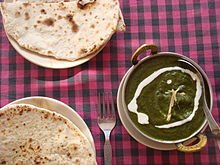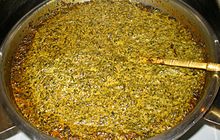Saag (pronounced [saːg]) (Punjabi: ਸਾਗ) (Nepali: साग) (Odia: ଶାଗ)or sag is a leaf-based (spinach, mustard leaf, collard greens, basella, etc.) dish eaten in the Indian subcontinent with bread such as roti or naan,[1] or rice (in Nepal, Odisha and West Bengal). Saag can be made from spinach, mustard leaves, finely chopped broccoli, or other greens, along with added spices and sometimes other ingredients such as paneer. On some menus, it is called saagwala.
Mutton (sheep) saag with naan bread

Saag paneer: spinach and cheese

Saag is more common in the region of Odisha, where it is eaten with Pakhala, and Punjab, especially sarson da saag, where it may be eaten with makki di roti.[2] It is also eaten in Nepal and in Haryana. This roti is made of maize flour and is yellow in colour, though it can also be eaten with other breads. Saag/saj however can be a catch-all term for various green-leaved dishes. It is one of the important dish of Mahaprasad (Jagannath Temple), where it has been served to the Lords for centuries. Saag aloo (spinach potato) and saag gosht (spinach and goat) is a common dish in Punjabi cuisine as served in restaurants and take-aways in the Western world (where the goat is commonly replaced with lamb).[3]
Variations
Odisha
In Odia cuisine, sāga is one of the most important vegetables.It is popular all over the state. A large varieties of plants are used as sāga in Odisha. A list of the plants that are used as sāga is as below.
Kalama sāga (କଳମ ଶାଗ) Ipomoea aquatica (Water Spinach)
Kosalā/Khadā sāga (କୋସଳା ଶାଗ/ଖଡା ଶାଗ): prepared from amaranth leaves.
Bajji sāga (ବଜ୍ଜୀ ଶାଗ): Prepared from Amaranthus dubius leaves.
Leutiā sāga (ଲେଉଟିଆ ଶାଗ)Amaranthus viridis leaves and tender stems.
Pālanga sāga (ପାଳଙ୍ଗ ଶାଗ) spinach
Poi sāga (ପୋଈ ଶାଗ): prepared from basella leaves and tender stems.
Bāramāsi/Sajanā sāga (ବାରମାସି/ ସଜନା ଶାଗ): prepared from leaves of the drumstick tree. Cooked with lentils or alone with fried onions.
Sunusuniā sāga (ସୁନୁସୁନିଆ ଶାଗ) Marsilea polycarpa leaves.
Pitāgama sāga (ପିତାଗମା ଶାଗ)
Pidanga sāga (ପିଡଙ୍ଗ ଶାଗ)
Kakhāru sāga (କଖାରୁ ଶାଗ): Prepared from leaves of the pumpkin plant.
Madarangā sāga (ମଦରଙ୍ଗା ଶାଗ): prepared from leaves of Alternanthera sessilis.
Sorisa saga (ଶୋରିସ ଶାଗ) : Mustard greens
Methi sāga (ମେଥୀ ଶାଗ): prepared from methi or Fenugreek leaves and besara (mustard paste) cooked with vegetable.[4]
Matara sāga (ମଟର ଶାଗ): The inner coating of peas is removed and then chopped to make the saga.
Bengali
In Bengali cuisine, sāg is one of the most important vegetables. It is popular all over the state. Most of the Bengalis use at least one sāg everyday during lunch. They eat sāg fried or little gravy (jhol) with rice. A list of the plants that are used as sāg is as below.
Kalmi sāg Ipomoea aquatica (Water Spinach)
Kosalā/Khadā sāg: prepared from amaranth leaves.
Bajji sāg: Prepared from Amaranthus dubius leaves.
Leutiā sāg Amaranthus viridis leaves and tender stems.
Pālong sāg: spinach
Puin sāg : prepared from basella leaves and tender stems.
Bāramāsi / Sojnā sāg: prepared from leaves of the drumstick tree. Cooked with lentils or alone with fried onions.
Sunusuniā sāg Marsilea polycarpa leaves.
Pitāgama sāg
Helencha sāg
Daata sāg
Peyanj sāg: prepared from Spring onions.
Mulor sāg
Lal sāg
Lau sāg : Prepared from the leaves and stems of bottle gourd plant.
Kumro sāg: Prepared from leaves of the pumpkin plant.
Madarangā sāg: prepared from leaves of Alternanthera sessilis.
Sorshe sag : Mustard greens
Methi sāg: prepared from methi or Fenugreek leaves and besara (mustard paste) cooked with vegetable.
Matara sāg: The inner coating of peas is removed and then chopped to make the sāga.
Punjab
Saag paneer or palak paneer is a dish that contains paneer cheese and mustard leaves.
Saag gosht is a version of the dish prepared with gosht (meat), often lamb. This version of the dish is more common in Pakistan since meat is a salient part of the country's cuisine. The meat is usually cooked in a tandoor before being marinated in the other ingredients.
Saag aloo, saag aalu or "palak aloo" is fried aloo (potatoes) dipped in spinach curry. It can be also made with mustard leaves, although spinach is more common. Saag aloo is commonly served hot, usually with naan, chapati, and makki di roti, and topped with ghee (clarified butter).